AN ANALYSIS OF TEACHERS’ WRITTEN FEEDBACK AND
TEACHER’S BELIEFS IN CRITICAL READING AND
WRITING II CLASS
A SARJANA PENDIDIKAN THESIS
Presented as Partial Fulfillment of the Requirements to Obtain the Sarjana Pendidikan Degree
in English Language Education
By
Herlina Dwi Sitarani Student Number: 101214045
ENGLISH LANGUAGE EDUCATION STUDY PROGRAM DEPARTMENT OF LANGUAGE AND ARTS EDUCATION FACULTY OF TEACHERS TRAINING AND EDUCATION
SANATA DHARMA UNIVERSITY YOGYAKARTA
i
AN ANALYSIS OF TEACHERS’ WRITTEN FEEDBACK AND
TEACHER’S BELIEFS IN CRITICAL READING AND
WRITING II CLASS
A SARJANA PENDIDIKAN THESIS
Presented as Partial Fulfillment of the Requirements to Obtain the Sarjana Pendidikan Degree
in English Language Education
By
Herlina Dwi Sitarani Student Number: 101214045
ENGLISH LANGUAGE EDUCATION STUDY PROGRAM DEPARTMENT OF LANGUAGE AND ARTS EDUCATION FACULTY OF TEACHERS TRAINING AND EDUCATION
SANATA DHARMA UNIVERSITY YOGYAKARTA
ii
A Sarjana Pendidikan Thesis on
AN ANALYSIS OF TEACHERS’ WRITTEN FEEDBACK AND
TEACHER’S BELIEFS IN CRITICAL READING AND
WRITING II CLASS
By
Herlina Dwi Sitarani Student Number: 101214045
Approved by
Advisor
iv
“NOTHING IS IMPOSSIBLE, THE WORD ITSELF SAYS
I’M POSSIBLE!”
-AUDREY HEPBURN-
My thesis is dedicated to my beloved
family especially my mother,
friends, and my lovely boy. I fight
for my life, no matter what. I can
do it well.
v
STATEMENT OF WORK’S ORIGINALITY
I honestly declare that this thesis, which I have written, does not contain the work or parts of the work of other people, except those cited in the quotations and the references, as a scientific paper should.
vi
LEMBAR PERNYATAAN PERSETUJUAN
PUBLIKASI KARYA ILMIAH UNTUK KEPERLUAN AKADEMIS
Yang bertanda tangan di bawah ini, saya mahasiswa Universitas Sanata Dharma:
Nama : Herlina Dwi Sitarani
Nomor Mahasiswa : 101214045
Demi pengembangan ilmu pengetahuan, saya memberikan kepada Perpustakaan Universitas Sanata Dharma karya ilmiah saya yang berjudul:
AN ANALYSIS OF TEACHERS’ WRITTEN FEEDBACK AND
TEACHER’S BELIEFS IN CRITICAL READING AND
WRITING II CLASS
beserta perangkat yang diperlukan (bila ada). Dengan demikian saya memberikan kepada Perpustakaan Universitas Sanata Dharma hak untuk menyimpan, mengalihkan dalam bentuk lain, mengelolanya dalam bentuk pangkalan data, mendistribusikan secara terbatas, dan mempublikasikannya di internet atau media lain untuk kepentingan akademis tanpa perlu meminta ijin kepada saya atau memberikan royalti kepada saya selama tetap mencantumkan nama saya sebagai penulis.
Demikian pernyataan ini saya buat dengan sebenarnya,
Dibuat di Yogyakarta
Pada tanggal : 13 November 2014
vii ABSTRACT
Sitarani, Herlina Dwi. 2014. An Analysis of Teachers‟ Written Feedback and
Teacher‟s Beliefs in Critical Reading and Writing II Class. Yogyakarta: English Language Education Study Program, Sanata Dharma University.
Feedback is an important means for teachers in teaching writing. Teachers use written feedback as a means to communicate between student and teacher in writing class. Teachers‟ written feedback is given to respond student‟s writing. The responses are different. They depend on the forms and types of teachers‟ written feedback. Moreover, every teacher also has different beliefs in teaching that underlie the practice of giving written feedback. Therefore, this research
focused on the analysis of teachers‟ written feedback in Critical Reading and
Writing II Class (CRW II). All of the teachers in CRW II became the main subjects in this research.
In this research, the researcher analyzed the teachers‟ written feedback in Critical Reading and Writing II class to interpret the teacher‟s beliefs by formulating two research problems: (1) What written feedback do teachers give in Critical Reading and Writing II Class? (2) What are the teachers‟ beliefs that underlie the practice of giving written feedback in Critical Reading and Writing II Class?
This is qualitative research which uses document analysis as the method.
There were 30 copied documents of teachers‟ written feedback as the documents from 6 classes. The researcher used the theory of feedback; the theory of the forms of feedback; the theory of the types of teacher‟s written feedback, and the theory of teacher‟s beliefs.
The researcher discovered that the teachers gave responses in the forms of direct feedback (crossing out, inserting or giving correct form) and indirect
feedback (underlining, giving circle, giving code or giving mark) on students‟
writing. The researcher also discovered that the type of teacher‟s written feedback in Critical Reading and Writing II Class was integrated feedback. Then, the
researcher obtained nine teacher‟s beliefs from the interpretation on the teachers‟
comments in written feedback. There were taking responsibility for the teaching, the need for others, description over prescription, a nonjudgmental stance, attention to language and behavior, avenues to awareness through exploration,
personal connections to teaching, attention to process, and a beginner‟s mind. The researcher concluded that the teachers‟ written feedback was a very important
means to improve students‟ writing and the teachers‟ beliefs were understood
from the practice of giving written feedback. Every teacher has different beliefs which underlie the teaching learning activity.
viii ABSTRAK
Sitarani, Herlina Dwi. 2014. An Analysis of Teachers‟ Written Feedback and
Teacher‟s Beliefs in Critical Reading and Writing II Class. Yogyakarta: Program Studi Pendidikan Bahsa Inggris, Universitas Sanata Dharma.
Umpan balik merupakan alat penting bagi para pengajar dalam mengajar pelajaran menulis. Pengajar menggunakan umpan balik tertulis sebagai alat komunikasi antara siswa dan pengajar di kelas menulis. Umpan balik tertulis diberikan pengajar untuk merespon tulisan para siswa. Respon-respon yang berbeda bergantung pada bentuk dan jenis umpan balik tertulis yang diberikan pengajar. Selain itu, setiap pengajar juga memiliki keyakinan-keyakinan yang berbeda dalam mengajar yang mendasari praktek pemberian umpan balik tertulis. Fokus penelitian ini pada analisis umpan balik tertulis dari pengajar di kelas Critical Reading and Writing II (CRW II). Seluruh pengajar di kelas CRW II menjadi subjek utama dalam penelitian ini.
Peneliti menganalisa umpan balik tertulis dari pengajar di kelas CRWII untuk menafsirkan hal-hal yang diyakini pengajar dengan merumuskan dua rumusan masalah: (1) Seperti apakah umpan balik tertulis yang diberikan oleh pengajar di kelas Critical Reading and Writing II? (2) Apa saja hal-hal yang diyakini pengajar yang mendasari praktek pemberian umpan balik tertulis di kelas Critical Reading and Writing II? Penelitian kualitatif ini menggunakan metode dokumen analisis. Sejumlah 30 dokumen salinan umpan balik tertulis dari pengajar sebagai dokumen yang berasal dari 6 kelas. Peneliti menggunakan teori tentang umpan balik, teori tentang bentuk umpan balik, teori tentang jenis umpan balik tertulis dari pengajar, dan teori tentang hal-hal yang diyakini para pengajar.
Peneliti menemukan bahwa para pengajar memberi tanggapan dalam bentuk umpan balik langsung (menyilang, menyisipkan atau memberi pembetulan) dan umpan balik tak langsung (menggarisbawahi, melingkari, mengode, atau menandai) pada tulisan-tulisan siswa. Peneliti juga menemukan jenis umpan balik tertulis dari pengajar di kelas CRW II berupa umpan balik yang tergabung. Peneliti mendapatkan sembilan keyakinan pengajar dari tafsiran pada komentar-komentar pengajar didalam umpan balik tertulis. Hal-hal yang diyakini pengajar antara lain: adanya tanggung jawab dalam mengajar, kebutuhan untuk orang lain, penggambaran lebih dari ketentuan, sudut pandang yang tidak mengadili, perhatian pada bahasa dan perilaku, cara-cara untuk menyadarkan melalui eksplorasi, hubungan individu dalam mengajar, perhatian pada proses, dan pemikiran seorang pemula. Peneliti menyimpulkan bahwa umpan balik tertulis dari pengajar merupakan alat yang sangat penting untuk memperbaiki tulisan-tulisan siswa dan hal-hal yang diyakini pengajar dapat dilihat dari praktek pemberian umpan balik tertulis. Setiap pengajar memiliki keyakinan-keyakinan yang berbeda yang mendasari kegiatan belajar mengajar.
ix
ACKNOWLEDGEMENTS
This thesis is like a miracle in my life. I would like to thank Allah S.W.T.
for the blessing, for the love, for the miracle, and for the strength given to me.
Allah S.W.T gives a wonderful plan in my life. Therefore, I could finish this
thesis because of help from Allah S.W.T.
My deepest gratitude is given to my advisor, Barli Bram M.Ed., Ph.D.
for his time, his guidance, and his help during the last semester that really
encouraged me to do my best for this thesis. I would thank Drs. Concilianus
Laos Mbato M.A., Ed.D., Caecilia Tutyandari M.Pd., Markus Budiraharjo
M.Ed., Ed.D., Monica Ella Harendita M.Ed., & Truly Almendo Pasaribu
S.S., M.A., who had permitted me to obtain the data from their classes. I also
would thank Fx. Ouda Teda Ena M.Pd., Ed.D. for his time, help, and
suggestions in order to finish my thesis. I say thanks very much to my beloved
senior, Sandy Ferianda S.Pd., who had given me a lot of suggestions and support
in order to complete my thesis.
My special gratitude is given to my beloved family, Papa dr. Achmad
Thabrani Sp.P.D. for the life lessons, Mama Hermastuti for her sacrifice and
prayer for me, and Fani Bastian who always make me become stronger day by
day. I know that they really love me unconditionally. I also would thank Ebedia
Hilda Am, my lovely sister for her help.
I also give my special thanks to my best friends ever in this world, Eswara
Kathina Dewi, Valentina Danova, Sebastianus Seno Kurniawan, Vinencia
x
Anggi Arumsari, and Guida Paradita who have given their care and support to
always be there for me. Last but not least, Ibu Asil Mulyani, who really cares
about me and Deny Pradita Tri Handaru for the four years wonderful love
story; he is still the one that I love so much although he is not mine.
I promise to be a better person and do my best for those that I could not
mention one by one. This is not the end but the beginning of the real life to the
next journey. Allahumma yassir wala tu‟assir.
The writer
xi
TABLE OF CONTENTS
TITLE PAGE ... i
APPROVAL PAGES ... ii
DEDICATION PAGE ... iv
STATEMENT OF WORK‟S ORIGINALITY ... v
PERNYATAAN PERSETUJUAN PUBLIKASI ... vi
ABSTRACT ... vii
ABSTRAK ... viii
ACKNOWLEDGEMENTS ... ix
TABLE OF CONTENTS ... xi
LIST OF TABLES ... xv
LIST OF FIGURES ... xvii
LIST OF APPENDICES ... xviii
CHAPTER I: INTRODUCTION ... 1
A. Research Background ... 1
B. Research Problems ... 5
C. Research Limitation ... 5
D. Research Objectives ... 6
E. Research Benefits ... 6
xii
CHAPTER II: REVIEW OF RELATED LITERATURE ... 10
A. Theoretical Description ... 10
1. Theory of Feedback ... 10
a. The Concept of Feedback ... 10
b. Forms of Feedback ... 13
1) Direct Feedback ... 13
2) Indirect Feedback ... 15
c. Purposes of Feedback ... 18
d. Feedback in Learning ... 20
2. Theory of Teacher‟s Written Feedback ... 21
a. Definition of Teacher‟s Written Feedback ... 21
b. Types of Teacher‟s Written Feedback ... 22
1) Form-focused Feedback ... 22
2) Content-based Feedback ... 23
3) Integrated Feedback ... 23
3. Theory of Teacher‟s Beliefs ... 24
a. Taking Responsibility for Our Own Teaching ... 27
b. The Need for Others ... 27
c. Description over Prescription ... 28
d. A Nonjudgmental Stance ... 29
e. Attention to Language and Behavior ... 30
f. Avenues to Awareness through Exploration ... 30
g. Personal Connections to Teaching... 31
h. Attention to Process ... 32
i. A Beginner‟s Mind ... 32
B. Theoretical Framework ... 33
CHAPTER III: RESEARCH METHODOLOGY ... 36
A. Research Method ... 36
xiii
C. Research Subjects ... 39
D. Instruments and Data Gathering Technique ... 39
E. Data Analysis Technique ... 41
F. Research Procedure ... 45
CHAPTER IV: RESEARCH RESULTS AND DISCUSSION ... 48
A. The Teachers‟ Written Feedback in Critical Reading and Writing II ... 48
1. Forms of Feedback ... 51
a. Direct Feedback ... 51
b. Indirect Feedback... 59
2. Types of Teacher‟s Written Feedback ... 68
a. Form-focused of Feedback ... 69
b. Content-based Feedback ... 69
c. Integrated Feedback ... 74
B. Teacher‟s Beliefs that Underlie the Practice of Giving Written Feedback .. 77
1. Taking Responsibility for Our Own Teaching ... 81
2. The Need for Others... 83
3. Description over Prescription ... 84
4. A Nonjudgmental Stance ... 86
5. Attention to Language and Behavior ... 87
6. Avenues to Awareness through Exploration ... 89
7. Personal Connections to Teaching ... 90
8. Attention to Process ... 92
9. Beginner‟s Mind ... 93
CHAPTER V: CONCLUSIONS AND RECOMMENDATIONS ... 98
A. Conclusions ... 98
B. Recommendations ... 101
xiv
2. Recommendations for Future Researchers ... 103
REFERENCES ... 104
xv
LIST OF TABLES
Table Page
3.1 Categories for Teachers‟ Written Feedback ... 42
3.2 Forms of Teachers‟ Written Feedback ... 43
3.3 Teacher‟s Beliefs in Teaching ... 44
4.1 The Examples of Crossing out an Unnecessary Word ... 52
4.2 The Examples of Inserting the Missing Word ... 54
4.3 The Examples of Writing the Correct Form ... 56
4.4 The Frequency of the Use of Direct Feedback... 58
4.5 The Examples of Underlining ... 61
4.6 The Examples of Giving Circle... 62
4.7 The Examples of Giving Code ... 64
4.8 The Examples of Giving Mark ... 65
4.9 The Frequency of the Use of Indirect Feedback ... 66
4.10 The Examples of Form-focused Feedback ... 69
4.11 The Examples of Content-based Feedback in Class C... 70
4.12 The Examples of Content-based Feedback ... 72
4.13 The Examples of Integrated Feedback ... 74
4.14 The Examples of Teacher‟s Belief 1 ... 82
4.15 The Examples of Teacher‟s Belief 2 ... 83
4.16 The Examples of Teacher‟s Belief 3 ... 85
4.17 The Examples of Teacher‟s Belief 4 ... 86
xvi
4.19 The Examples of Teacher‟s Belief 6 ... 89
4.20 The Examples of Teacher‟s Belief 7 ... 91
4.21 The Examples of Teacher‟s Belief 8 ... 92
4.22 The Examples of Teacher‟s Belief 9 ... 93
xvii
LIST OF FIGURES
Figure Page
2.1 Cycle of Using Feedback in Writing ... 11
2.2 Direct Feedback on Writing ... 14
2.3 Indirect Feedback on Writing... 17
xviii
LIST OF APPENDICES
Appendix Page
APPENDIX 1 Permission Letter Class A & F ... 107
APPENDIX 2 Permission Letter Class B ... 108
APPENDIX 3 Permission Letter Class C ... 109
APPENDIX 4 Permission Letter Class D ... 110
APPENDIX 5 Permission Letter Class E ... 111
APPENDIX 6 Data of Teacher‟s Written Feedback Class A ... 112
APPENDIX 7 Data of Teacher‟s Written Feedback Class B ... 117
APPENDIX 8 Data of Teacher‟s Written Feedback Class C ... 124
APPENDIX 9 Data of Teacher‟s Written Feedback Class D ... 128
APPENDIX 10 Data of Teacher‟s Written Feedback Class E ... 134
APPENDIX 11 Data of Teacher‟s Written Feedback Class F ... 139
APPENDIX 12 Crossing out an Unnecessary Word, Phrase, or Morpheme ... 143
APPENDIX 13 Inserting the Missing Word or Morpheme ... 147
APPENDIX 14 Writing the Correct Word or Form near the Erroneous Form ... 150
APPENDIX 15 Underlining Word or Sentence ... 153
APPENDIX 16 Giving Circle on the Word or Sentence ... 162
APPENDIX 17 Giving Code on Written Feedback ... 168
APPENDIX 18Giving Mark on Written Feedback ... 170
APPENDIX 19 Teacher‟s Beliefs in Class A ... 172
APPENDIX 20 Teacher‟s Beliefs in Class B ... 175
xix
APPENDIX 22 Teacher‟s Beliefs in Class D ... 180
APPENDIX 23 Teacher‟s Beliefs in Class E ... 184 APPENDIX 24 Teacher‟s Beliefs in Class F ... 187
1
CHAPTER I
INTRODUCTION
This research focuses on an analysis of teachers‟ written feedback in
Critical Reading and Writing II Class. This chapter presents six major sections,
namely the research background, research problems, research limitation,
research objectives, research benefits, and definition of terms.
A. Research Background
English is the most commonly used language among people as an
international language. It is now considered as the language of communication
for the entire people in the globalization era. According to Abadi and Marzban
(2012, p. 23), “English as second language being widely used in many different
areas such as tourism, telecommunication, science, and technology seems to be
not only means but also as key to obtain the latest achievements in such areas,...”
In the education field, the English Language Education Study Program (ELESP)
of Sanata Dharma University is one of the study programs to learn English as
Second Language (ESL) in Indonesia. The teachers of ELESP teach English in
order to educate their students to be English teachers in the future.
Abadi and Marzban (2012, p. 24) also state that there are four skills in
teaching English, namely listening, speaking, reading, and writing. This research
focuses on writing skills. In the ELESP, there are some courses to improve the
courses are Basic Writing, Paragraph Writing, Critical Reading and Writing 1,
Critical Reading and Writing 2, Academic Essay Writing, Proposal Seminar,
Business Writing, Creative Writing, and Thesis/Final Paper. In this research, the
researcher focuses on Critical Reading and Writing 2 Class. Every student in this
study program learns how to use and apply English in writing correctly.
Langan (2011, p. 11) states that “realistic attitude about writing must
build on the idea that writing is a skill, not a “natural gift”. It is a skill like
driving, typing, or cooking; and, like any skill, it can be learned”. Therefore,
writing skill can be learned and improved by having a lot of practices. Moreover,
Hyland (2003, p. 9) states that “writing is a way of sharing personal meanings
and writing courses emphasize the power of the individual to construct his or her
own views on a topic.” Critical Reading and Writing II Class is one of the
courses in ELESP in which writing is taught. The teachers ask the students to
write an essay using certain topic. Furthermore, all of the ELESP students are
required to be able to use English in writing correctly because they will compile
a thesis or final paper at the end of their study. Thus, in order to improve their
writing skill, the students need feedback from their teachers.
Feedback becomes a means of communication between the teachers and
the students in the process of learning language. Lewis (2002, p. 5) states
“feedback can be like a conversation between student and teacher and, as in the
case of conversation, things can sometimes go wrong.” In Critical Reading and
have submitted their projects. The teachers give specific, clear, and meaningful
feedback to avoid misunderstanding between the teachers and the students.
The teachers can write anything on feedback such as suggestions,
positive evaluation, additional information, comments, and advices. Therefore,
the teachers know the students‟ progress in each project from the written
feedback on students‟ writing. The process in writing is a real learning process
of language because the students have to apply the language correctly.
Feedback is very important; it becomes meaningful for the students
because feedback gives some effects. There are two effects of feedback as Lewis
(2002, p. 6) states “at the best, a student feels encouraged and keeps trying but
at the worst, the student feels that it is no use working hard because the teacher‟s
feedback a method dwells on what is wrong”. Feedback is not only given to
student as a motivation in writing but also to indicate errors in writing. The
feedback from the teachers has positive and negative effects as mentioned
previously. It depends on the students‟ attitudes in learning.
The feedback can be a positive means if the students are motivated to
write better, but it can be a negative means if the students are not motivated in
the feedback from the teachers. Moreover, the teachers have to give clear
explanation on their feedback which makes the students revise their writing
easily. Teachers also have to give feedback on the students‟ writing objectively.
Therefore, feedback from teachers does not only focus on the students‟
After obtaining the feedback from the teachers, the students should be
motivated to learn English. The students‟ motivation depends on the teachers‟
feedback whether it is helpful for the students. It becomes a supportive means
when the students are motivated to write accurately. Thus, the teachers must be
careful in giving feedback. The feedback should give positive motivation for the
students. The use of feedback in the process of learning language is to motivate
the students to improve their skills and knowledge in writing.
Lewis (2002, p. 4) states “feedback can encourage students to study and
to use language to the best of their ability by taking into account whatever the
teacher knows about students‟ attitudes”. It can be concluded that feedback has a
big role in learning language in order to learn and use English correctly. In the
English Language Education Study Program (ELESP), the feedback is used by
the teachers in some courses. Critical Reading and Writing II Class (CRW II) is
one of the courses that use the feedback in the teaching learning activity. In this
course, the students are required to read and write about a certain topic critically.
This research analyzed the teachers‟ written feedback in CRW II classes.
The researcher conducted qualitative research in order to investigate the
teachers‟ written feedback and identified the teacher‟s beliefs that underlie the
practice of giving written feedback because every teacher has different methods
in giving written feedback. This research was conducted to the teachers who
were teaching Critical Reading and Writing II Class in academic year
2013/2014. The teachers in CRW II Class give written feedback to the students
B. Research Problems
There are two research problems that will be investigated in this
research:
1. What written feedback do teachers give in Critical Reading and Writing II
Class?
2. What are the teachers‟ beliefs that underlie the practice of giving written
feedback in Critical Reading and Writing II Class?
C. Research Limitation
This research focuses on the analysis of written feedback as the
documents from the teachers to the students in order to investigate the form and
type of written feedback that teachers give in Critical Reading and Writing II
Class. In addition, the researcher interprets the teachers‟ written feedback to
obtain the teacher‟s beliefs that underlie the practice of giving written feedback
in Critical Reading and Writing II Class. The researcher uses teachers‟
comments to obtain the teachers‟ beliefs. There are six classes of Critical
Reading and Writing II. However, there are 5 teachers who teach Critical
Reading and Writing II. Therefore, the researcher focuses on the teachers‟
written feedback in detailed to be analyzed later. The copied version of teachers‟
written feedback became the only one source in the research because this
D. Research Objectives
There are two objectives of this research:
1. To investigate the written feedback given by the teachers in Critical Reading
and Writing II Class.
2. To interpret the teachers‟ beliefs that underlie the practice of giving written
feedback in Critical Reading and Writing II Class.
E. Research Benefits
This research is conducted to investigate the analysis of written
feedback provided by the ELESP teachers in Critical Reading and Writing II
Class in order to interpret the teacher‟s beliefs. The expectation from this
research will give some benefits to the English Language Education of Study
Program, especially for:
1. The ELESP Teachers of Sanata Dharma University
The findings of this research help the ELESP teachers to give written
feedback to their students in Critical Reading and Writing II Class. It will give
some suggestions for ELESP teachers in giving written feedback to the
students. They will also know whether their feedback is helpful for the
students. Therefore, the teacher can use written feedback effectively.
2. The ELESP Students of Sanata Dharma University
This research will help the students to obtain some benefits of using
motivate the students to improve their writing skill in making essay in the
Critical Reading and Writing II Class. In addition, the students can understand
how to use the written feedback from the teacher in order to revise their writing.
3. The Future Researchers
This research can be an inspiration to other researchers who are
interested to do a research with the same topic which is about teacher‟s written
feedback. The use of feedback is really important in the teaching learning
activity in classroom. Moreover, feedback is a means that can be improved and
modified to support the teaching learning for education.
F. Definition of Terms
The researcher provides four definitions of terms used in this research:
1. Feedback
Lewis (2002, p. 3) defines feedback as “a method for teachers to
describe their students‟ language.” Moreover, Sherman (1994, p. 57) also
defines feedback as “a response or reaction from another person to something
people do, that can be used to help people assess and improve on their
performance in the future.” From those definitions, the researcher used
2. Teacher’s Beliefs
Every teacher has different beliefs in teaching. According to Borg
(2001, p. 187), “teachers‟ beliefs are those beliefs relevance to an individual‟s
teaching.” This research focuses on the teacher‟s beliefs in giving the written
feedback in teaching writing. Eggen and Kauchak (2012, p. 69) state that
teacher‟s beliefs are not skills. However, teacher‟s beliefs are important to
create a positive classroom climate or to increase student motivation. The
researcher analyzes the teacher‟s beliefs that underlie the practice of giving
written feedback in CRW II. The beliefs influenced the practice of giving
written feedback whether direct or indirect written feedback.
3. Critical Reading and Writing Class
The researcher proposes a theory of Critical Reading and Writing II
based on Buku Panduan Akademik Program Studi Pendidikan Bahasa Inggris,
(2011, p. 38), CRW 2-KPE 221 (4 CR / 4 CH). Critical Reading and Writing 2
is designed as a project-based class to facilitate students to access into a large
amount of reading through which students acquire information, which thus
enhances the progress of their knowledge and the development of their critical
reading and writing skills. There are five teachers who teach this subject. The
researcher wants to know the form and type of written feedback from the
teachers. Each teacher has a different method on giving feedback. The focus in
this research is developing writing skills by generating argumentative writing
4. English Language Education Research Program (ELESP) Teachers
The researcher defines the term of ELESP teachers as the teachers who
are teaching English to the students in Sanata Dharma University. They have
ability in English education to educate their students to become English
teachers in the future. In this research, the researcher focuses on the English
Language Teaching (ELT) of the teachers in the Critical Reading and Writing
10 CHAPTER II
REVIEW OF RELATED LITERATURE
This chapter attempts to contextualize some related theories to address the
research problems in previous chapter. It consists two important major sections,
namely the theoretical description and theoretical framework.
A. Theoretical Description
There are 3 major areas discussed in this sub-chapter. They are the theory
of feedback, theory of teacher‟s writtenfeedback, and theory of teacher‟s beliefs.
1. Theory of Feedback
In this part, the researcher presents the theory of feedback including the
concept of feedback, forms of feedback, purpose of feedback, and feedback in
learning.
a. The Concept of Feedback
There are many definitions of feedback proposed by many experts.
According to Sherman (1994, p. 57) feedback is a “response or reaction from
another person to something people do, that can be used to help people assess and
improve on their performance in the future." The form of response or reaction
thing. The response or reaction on feedback can be in the form of comments. The
comments give an improvement to the people after they do or learn about
something. Feedback can also be used to help people assess and improve their
performance in the future. The improvement in doing something can be seen
clearly after obtaining feedback. Thus, Srichanyachon (2012, p. 8) also agrees that
“feedback is an essential component of any English language writing course”. In
practice, people who obtain feedback on their performance want to make a change
for better results.
Moreover, Hillocks (1986, p. 220) also states “feedback represents the
objectives of instruction to some extent”. Contextually, the researcher defines the
term extent as the further study on writing. It will improve the students‟ writing
skill in order to have a good quality for their writing. The expectation of feedback
is to help the teachers to share their knowledge in writing to the students. The
process of writing using feedback from others can be taken as an example:
Figure 2.1 Cycle of Using Feedback in Writing (From Sherman (1994, p. 57))
You give a piece of your writing to someone
You obtain reactions
and comments
on your writing You read
the comments As a
result, you change the way you write
Similar to Sherman‟s cycle, Lewis (2002, p. 5) also states that “feedback
can be like a conversation between student and teacher.” There is a
communication in teaching activity between the teacher and the student in order to
know the students‟ progress in their writing. Todd et al (2001, p. 2) have the same
idea about feedback as a communication between the students in which teachers
give comments conveying suggestions, positive evaluation, information or support
towards the participants. Those are regarded as useful possibly because such
comments can promote trust and build relationships between teachers and
students. Therefore, teachers can develop a good communication in order to make
a good atmosphere in teaching learning of language classroom because teachers
and students can discuss anything about writing for the students‟ improvement.
The communication on feedback is to discuss two parts. Lewis (2002, p. 8)
states that “the focus of feedback is not only on the students‟ errors or errors in
their writing but also on students‟ abilities.” The students‟ errors are misspelling
or error typing. In addition, errors in students‟ writing are error in grammar, error
in citation, and error in quotation. Therefore, the students‟ writing will be
improved and revised later. Then, the teachers give some corrections on the
students‟ writing. On the other hand, feedback can also measure the students‟
ability in writing because the teachers know the quality of students‟ writing from
the feedback. It happens because feedback also gives information about language
b. Forms of Feedback
Hyland and Hyland (2006, p. 83) explain about two forms of written
feedback in students‟ writing. They present the distinction in the forms of
feedback between direct and indirect feedback. Moreover, Srichanyachon (2012,
p. 7) also states that written feedback can be given directly or indirectly on
students‟ writing. It shows two different forms on giving written feedback in the
writing class.
According to Bitchener, Young, and Cameron (2005, p. 193), they conduct
the research in direct feedback and indirect feedback. Direct or explicit feedback
occurs when the teacher identifies an error and provides the correct form, while
indirect strategies refer to situations when the teacher indicates that an error has
been made but does not provide a correction, thereby leaving the student to
diagnose and correct it. The teacher‟s feedback helps the students to revise their
writing.
1. Direct Feedback
Hyland and Hyland (2006, p. 83) define that direct feedback may take
various forms, including crossing out an unnecessary word, phrase, or morpheme;
inserting a missing word or morpheme; or writing the correct word or form near
the erroneous form (e.g., above it or in the margin). It means the teachers give the
correction on the students‟ writing directly. Crossing out an unnecessary word,
phrase, or morpheme is to make it clear that the word is not required in the
Next, direct feedback can be recognized by using inserting a word to give
the correct word or morpheme. Then, the teacher adds and writes the correct word
or forms directly on the students‟ writing. Therefore, the students revise the error
on writing easier because they know the correct word or morpheme. Moreover,
Srichanyachon (2012, p. 10) also states that direct feedback is a technique of
correcting students‟ error by giving an explicit written correction. It helps the
student to recognize their error because the teacher gives the correct form near the
erroneous form. Below is the example of direct feedback on student‟s writing.
Srichanyachon (2012, p. 11) also writes that teachers should also give
clear explanations about grammatical errors on giving direct feedback to the
students. It can deepen the students‟ English knowledge. The correct form of the
teachers‟ correction can be written explicitly. The students will know their errors
and revise it later. It is easy for the students to revise the errors but it takes long
time for the teacher in giving feedback.
Moreover, the teachers can write anything about writing to help the
students‟ writing better. Bitchener, Young, and Cameron (2005, p. 196) define
that direct written feedback takes the form of full, explicit correction above the
underlined errors. It makes the students easy to understand what the teachers
intend on their written feedback. Similarly, Vyatkina (2011, p. 64) also mentions
that direct teacher‟s written feedback is that the teacher writes suggestion by
giving the accurate form next to highlighted errors. The students can also learn
something new from the correct form of teacher‟s written feedback because the
additional information about language is available.
2. Indirect Feedback
Hyland and Hyland (2006, p. 83) define that indirect feedback occurs
when the teacher indicates in some method that an error has been made – by
means of an underline, circle, code, or other mark – but does not provide the
correct form, leaving the student to solve the problem that has been called to his
or her attention. The form of indirect feedback on students‟ writing is to help the
In addition, Vyatkina (2011, p. 64) says that indirect teacher‟s written
feedback is teachers indicate the location of errors by underlining or circling with
or without attaching any metalinguistic error code. The use of sign language or
hints is used there. Code is also used in giving indirect feedback to the students‟
writing. According to Srichanyachon (2012, p. 9), “L2 students prefer errors
marked with teachers‟ codes because it is easy for them to edit and improve their
papers.” These kinds of code have a goal to make the students become more
independent as an ESL learner.
The teachers choose to use this kind of feedback because it is easy for
them to mark the errors. They already know the students‟ errors but they let the
students solve and revise the errors by themselves. The teachers guide the students
by giving some hints on their writing. Thus, Srichanyachon (2012, p. 10) also
states that indirect feedback is when the teacher indicates that an error has been
made by means of an underline, circle, code, etc. After the teachers give the
indirect feedback, the students analyze the writing to recognize their errors.
Hyland and Hyland (2006, p. 207) also write that “the way teachers choose
to express their feedback can affect both students‟ reactions to it and the extent to
which they use it in their revisions, and may have significant impact on writing
development.” It is important for the teachers to find an appropriate way in giving
feedback for student‟s writing. The form of feedback depends on the students‟
needs for the further writing. Figure 2.3 in the following page is an example of
Figure 2.3 Indirect Feedback on Writing from http://jitp.commons.gc.cuny.edu
The two forms of feedback previously can help the students revise the
errors. Most of the students make the errors in their writing unconsciously.
Therefore, the teachers have to decide an appropriate form as their method in
giving feedback. However, Srichanyachon (2012, p. 11) states that a combination
of direct feedback and indirect feedback can be used for students in large mixed
c. Purposes of Feedback
Lewis (2002, pp. 3-4) proposes five purposes of giving feedback for
students and teachers. The explanation of each purpose is in the following section.
The first, Lewis (2002, p. 3) mentions “feedback provides information for
teachers and students". It means that teachers can recognize all of the information
about students‟ writing skill. They also use feedback to observe or evaluate their
teaching learning process in the class. On the other hand, students obtain much
information about their writing from teachers. It is a chance for students to learn
many things from the feedback. Feedback conveys the teachers‟ language in order
to communicate with the students during the learning process.
The second, Lewis (2002, p. 4) writes feedback is to give advice about a
learning process on the students‟ writing. Feedback becomes a means in the
learning process to control and guide the students‟ progress on writing. Raimes
(1983, p. 141) says that “the teacher as sympathetic reader and editor can
intervene at various points in the process.” It means that the teachers read the
students‟ writing and give correction on it. The teachers are involved in the
students‟ writing in the process of teaching learning. The teachers give advice on
their feedback as an input for the students‟ writing. The advice from teacher is
optional so that the students can either use it or not. Furthermore, the advice not
only can develop the students‟ skill in writing, but also can evaluate their ability.
The third, Lewis (2002, p. 4) states “feedback provides meaningful and
individual language input. Feedback should be a meaningful means for the
efficiently. If the teachers give meaningful feedback, it makes the students
understand the feedback easily. The students obtain individual language input
because they learn the new knowledge (vocabulary, grammar, idiom, diction, and
so on) from the teachers about the written language. The teachers have to share
their knowledge about language to the students.
According to Lewis (2002, p. 4), the fourth purpose is that feedback can
motivate the students. Feedback will encourage the students to learn the language
features further. Brown (2007, p. 89) mentions that “The positive feedback that
students perceive as a boost to their feelings of competence and
self-determination.” It means that feedback can motivate the students to be challenged
in writing correctly and accurately. After that, it makes the students have their
own self-determination in the future. They become more independent and
confident in English writing correctly. The curiosity in learning the language
happens because they want to master the language well. Then, the students will
use the language correctly because they have good knowledge after the teachers
give the feedback. It is a kind of motivation in learning language for the students.
Fifth, feedback, Lewis (2002, p. 4) writes that feedback has a purpose to
lead the students toward autonomy. Feedback makes the students become more
independent because they can recognize and revise the errors in writing by
themselves. Leng (2013, p. 390) states that feedback acts as a compass which
provides a sense of direction to the students and tells that writing goals are
achievable. They also feel confident in using language. From that, the purposes of
Feedback gives many contributions in the teaching learning activity. It also
becomes a means for the teachers in classroom.
d. Feedback in Learning
Feedback becomes a means of communication in the teaching learning
activity. It is provided by teachers to communicate with students. In this research,
feedback is given after the students write something about certain topic. The kind
of feedback in writing from the teacher can be in the form of a written feedback,
as Sherman (1994, p. 58) defines “the feedback is the comments and reactions of
your reader(s) and your teacher/tutor”. The teachers also know the progress of the
students‟ writing. Therefore, the students need feedback from the teacher to make
improvement in their writing.
Feedback will be useful if the students read and use it properly. In the
writing class, the teachers ask the students to make a draft of their writing. Next,
the teachers will give the written feedback on their draft to make the final draft
better. Lewis (2002, p. 16) states that “instead of simply marking completed work,
teachers give comments on the draft.” It means that the teachers do not only give a
mark/sign on the students‟ writing but also explain it using meaningful comments.
In addition, Lewis (2002, p. 12) writes that “feedback is not limited to
commenting on errors”. It means that feedback also has a role to motivate the
students. The teachers can mention what the students are doing well in their
2. Theory of Teacher’s Written Feedback
In this part, the researcher presents the theory of teacher‟s written
feedback. The theory of teacher‟s written feedback includes the definition of
teacher‟s written feedback and the types of teacher‟s written feedback.
a. Definition of Teacher’s Written Feedback
Hyland and Hyland (2006, p. 206) state that teacher written feedback is
designed to carry a heavy informational load, offering commentary on the form
and content of a text to encourage students to develop their writing and
consolidate their learning. The teachers become one of the sources of any
information about writing for the students. Therefore, they have an important role
to give comments on the students‟ writing. The comments are not only about the
form but also the content of the text after they read the text carefully. Moreover,
the comments should give contributions to the students to improve their skill. In
detailed, Srichanyachon (2012, p. 8) explains that teacher‟s written feedback can
be given in the form of written commentary as response from teacher. Therefore,
teacher‟s written feedback was given to students in order to indicate problems and
improve the next papers.
The explanation above is very clear that giving written feedback is very
important to improve the students‟ skill on writing. Teacher‟s written feedback
does not only give responses to the students‟ writing but also help the students to
develop their skill on writing. Lewis (2002, p. 3) explains that feedback is a
method for teachers to describe their students‟ language. It also gives the teachers
can be a form of evaluation on their teaching activity. From that, the researcher
knows that the use of feedback in the learning language activity is very important.
The teachers respond the students‟ writing in the form of meaningful comments
then the students will revise their writing. The revision is a progress from the
students that is also used by the teachers to evaluate their teaching.
b. Types of Teacher’s Written Feedback
In this part, the researcher shows the types of teacher‟s written feedback to
the student‟s writing. According to Park (2006, pp. 3-9), there are three types of
written feedback; (1) form-focused feedback, (2) content-based feedback, and (3)
integrated feedback which are the most commonly used in second language
writing class. In this research, the teacher used written feedback in Critical
Reading and Writing II Class for the ELESP students. Leng (2013, p. 390) states
that written feedback is used to teach writing skill that are able to help students
improve their writing. There were 3 types of teacher‟s written feedback in order to
improve students‟ skill on writing.
1) Form-focused Feedback
According to Park (2006, pp. 3-5), the first type is form-focused feedback.
The form-focused feedback is the written feedback provided by the teachers about
the grammar correction on the students‟ writing. Grammar correction is related
how to use language correctly based on grammar. Therefore, the students can
It can be useful for the improvement on grammatical knowledge such as
identifying and correcting students‟ errors.
2) Content-based Feedback
Park (2006, pp. 6-7) states that the second form of teacher‟s written
feedback is content-based feedback. It is also called as meaning-based feedback.
The content-based feedback focuses on the quality of content and organizational
features in the students‟ writing composition. The teachers provide overall
comments on which the student‟s writing does not make sense in terms of content
or give some comments on logical fallacies in writing without pointing out the
specific grammatical errors. Content-based feedback also related to ideas
organization.
3) Integrated Feedback
The third form of teacher‟s written feedback, Park (2006, pp. 8-9)
mentions integrated feedback. The integrated feedback is a kind of written
feedback by combining grammar correction with content-related feedback. The
teachers do not only give a correction on the grammar in order to help the students
improve the accuracy of grammar in writing but they also give motivational
comments on the students‟ ideas. Thus, it makes the students become more
confident in the writing.
These theories about feedback in this research focus on the teacher‟s
understand the feedback in learning. The kinds of feedback in this research can be
recognized from the form, direct or indirect feedback and the types, form-focused
feedback, content-based feedback or integrated feedback. It will be analyzed to
find out what kind of feedback used by the ELESP teachers to interpret teacher‟s
beliefs in Critical Reading and Writing II Class.
3. Theory of Teacher’s Beliefs
Critical Reading and Writing II is one of the writing course in English
Language Education Study Program of Sanata Dharma University. There are six
classes. Every class has a teacher to teach this course. Therefore, the differences
in teaching writing can be seen clearly. According to Borg (2001, p. 186), beliefs
have an important role in many aspects of teaching because beliefs can influence
the teacher to deliver the materials in teaching. In this research, the teacher‟s
beliefs influence the practice of giving written feedback to the students‟ writing.
The practice of giving written feedback is to help the students in order to
understand the new information or knowledge from the teachers. Moreover,
Johnson (1999, p. 30) states that “beliefs have a cognitive, an affective, and a
behavioral component and therefore act as influences on what we know, feel, and
do.” The researcher identifies every written feedback from teachers on students‟
writing in detail to obtain the teacher‟s beliefs. The teacher‟s beliefs on the
practice of giving written feedback can be recognized from the interpretation of
There were 5 teachers as the main subjects in this research. Borg (2001, p.
187) also states that “teachers‟ beliefs are those beliefs relevance to an
individual‟s teaching.” Every teacher has different beliefs on teaching as seen in
their teaching writing in Critical Reading and Writing II Class. Therefore, the
researcher investigates the teachers‟ written feedback to obtain the teacher‟s
beliefs that underlie the practice of giving written feedback in Critical Reading
and Writing II Class.
According to Brown and Webb (1968, p. 211), “research on the
relationship between beliefs and behavior in teaching has found that how teachers
behave in the classroom is strongly influenced by what they believe.” It showed
that the teacher‟s beliefs can influence the teachers‟ behavior on the practice of
giving written feedback. Similarly, Johnson (1999, p. 30) and Borg (2001, p. 186)
also state that the relationship between beliefs and behavior shaped beliefs to
dispose or guide teachers‟ thinking and action. The teachers have their own
beliefs in order to guide their written feedback on students‟ writing.
Fraenkel and Wallen (2006, p. 483) state that “a person‟s or group‟s
conscious and unconscious beliefs, attitudes, values, and ideas often are revealed
in their communications.” The teachers give written feedback to respond the
students‟ writing as the reader. In addition, there is a communication in the
teaching learning activity in classroom. The teachers communicate their beliefs
about writing in their written feedback. The teacher‟s beliefs influence the
teachers in giving responses. The responses can be accepted if the teachers use
However, it can be rejected if the students do not understand the responses on the
written feedback. Therefore, the teacher‟s beliefs have an important role on giving
written feedback.
In order to avoid the misunderstanding, the teachers can apply their beliefs
in teaching appropriately. Furthermore, Hyland & Hyland (2006, p. 207) state that
“in giving feedback we simultaneously offer a representation of ourselves as
teachers and as individuals, revealing our beliefs about language, learning,
writing, and personal relationships.” The researcher recognizes the different form
of written feedback from each teacher to be analyzed in order to obtain the
teacher‟s beliefs in teaching writing.
The teacher‟s beliefs also become the focus of written feedback provided
by the teacher such as language (grammar and vocabulary), learning (the kind of
text and organization ideas), writing (punctuation and generic structure), and
personal relationships (student‟s progress, reinforcement, and communication). As
a result, Schulz (2001, pp. 244-258) states that “the differences are evident in
what individual teachers think about feedback and how they handle it.” Every
teacher has different way on giving feedback based on the teacher‟s beliefs. It also
depends on how the teachers use their beliefs on written feedback.
Each teacher has certain beliefs that will be used in the teaching learning
activity. The teacher‟s beliefs distinguish the classroom practices. In the teaching
learning activity, the teachers need approach to convey the knowledge to the
students. According to Gebhard and Oprandy (1999, pp. 4-19), there are nine
teaching. The researcher uses these nine beliefs to interpret the teachers‟ written
feedback in teaching writing of Critical Reading and Writing II Class. The
explanation of each belief would be elaborated on the following pages.
a. Taking Responsibility for Our Own Teaching
The first belief is taking responsibility for our own teaching. Gebhard and
Oprandy (1999, p. 5) state that the teachers have responsibility in their own
teaching to deliver the knowledge to the students. Therefore, the teachers must
have the desire to explore themselves in order to enrich their knowledge in
teaching. This belief demands the teachers to become one of the sources of
knowledge for their students. The teachers also become bridges who are
delivering the knowledge in order to obtain the same ideas about how to write
well. The responsibility is needed to internalize new knowledge to the students in
order to avoid permanent error or misunderstanding. For example, a teacher has
responsibility to give clear and helpful feedback that can be used for the students
to revise their writing. Therefore, the student can understand what the teacher give
in the course.
b. The Need for Others
The second belief is the need for others. According to Gebhard and
Oprandy (1999, pp. 5-6), the teachers have a belief in the need for others in order
to explore their teaching. Teaching learning activity cannot be held without others
because it needs at least two people as a teacher and a student. Therefore, the
CRW II focuses on the teaching writing. There are some needs for the
students to improve their skill on writing. From that, both teacher and student can
explore and improve their skill, ability, and knowledge in teaching learning
activity. Giving written feedback based on students‟ needs also gave a new
experience for the teachers. It can help them to enrich their experience in teaching
writing.
The experiences from others give choices for the teachers on teaching
learning activity in the future. Gebhard and Oprandy (1999, p. 6) add that the
teachers have to attach themselves to their thoughts and words in order to avoid
the gap between the styles of writing. In this research, teaching learning in Critical
Reading and Writing II Class, the teachers give what students need for their
writing and the students accept knowledge from the teacher. Teacher‟s written
feedback was the students‟ need in their writing class.
c. Description over Prescription
The third belief is description over prescription. Gebhard and Oprandy
(1999, pp. 6-8) state that prescriptions have several problems in teaching. The
problems are that the teachers should follow the certain ways in teaching, which
can create confusion in teaching, can disturb the rights of teachers in their
teaching method, and cannot give freedom for teachers in exploring their teaching
method. Furthermore, prescriptive manner is how to teach well from the
Therefore, Gebhard and Oprandy (1999, p. 8) state that “descriptions
provide a way of portraying what happens in classrooms that can be useful for
us.” From that, the teachers can explore their teaching in order to evaluate the
method by themselves. The teachers can also use the descriptions to decide the
most appropriate method for teaching because every class has different
characteristic. In the practice of giving written feedback, teachers can decide the
best forms and types of written feedback on the students‟ writing. Descriptions
also allow the teachers to give written feedback in detail because the teachers can
write and give responses about anything that is related to the students‟ writing.
d. A Nonjudgmental Stance
The fourth belief is a nonjudgmental stance. Gebhard and Oprandy (1999,
pp. 8-9) state that the teachers have belief to give a nonjudgmental stance about
teaching because the judgmental remarks could limit the exploration of teaching
writing. It happens because every teacher has their own method to teach the
students. Therefore, this belief influences the teacher on giving different kinds of
written feedback in the class. Nonjudgmental stance makes the teacher to become
more independent in teaching. Similarly, the nonjudgmental stance is also given
to the written feedback for the students. The teacher had belief to give
nonjudgmental stance on their written feedback in order to give a chance for the
students to explore their skill on writing. A nonjudgmental stance on giving
e. Attention to Language and Behavior
The fifth belief is attention to language and behavior. Gebhard and
Oprandy (1999, pp. 10-13) state that the attention to language and behavior is
very important because in the use of dictions, the teachers have to avoid vague
language in teaching. The vague language can influence their teaching behavior
because the same words can give different meaning for different people. Vague
language can lead to the miscommunication in teaching. Therefore, Gebhard and
Oprandy (1999, p. 12) state that “the idea here is to use a metalanguage to talk
about teaching rather than to use general statements and words.” Specific words in
written feedback are easy to understand for the students.
f. Avenues to Awareness through Exploration
The sixth belief is avenues to awareness through exploration. According to
Gebhard and Oprandy (1999, pp. 13-15) the awareness through exploration can
use four avenues as the suggestion for different method in teaching. The first
avenue is problem solving. Problem solving is the avenue of the teacher to
understand the student‟s behavior and solve the student‟s problem. The second
avenues are seeing what happens by trying the opposite and seeing what happens
by adapting random teaching behavior. Gebhard and Oprandy (1999, p. 14) state
that “the idea is to discover what we normally do and try the opposite to see what
happens.” The teacher will obtain new ideas for the next activity. The teacher also
The third avenue is seeing what is by contrasting what we do with what we
think we do and seeing what is by considering what we believe in light of what we
do. Gebhard and Oprandy (1999, p. 14) state that “one is exploring what we
actually do in our teaching as opposed to what we think we are doing.” Moreover
the teachers need to consider about what the teacher‟s beliefs on the practice of
teaching. This avenue is to prove that the beliefs match the actual practices. The
last avenue is clarifying our feelings. Gebhard and Oprandy (1999, p. 15) state
that “the teacher can explore to gain emotional clarity in the end of teaching.”
Therefore, the teacher‟s feeling about things can affect our behavior because the
teacher needs to explore the emotional side. This belief can be used by the teacher
in order to improve their teaching especially in giving written feedback.
g. Personal Connections to Teaching
The seventh belief is personal connections to teaching. Gebhard and
Oprandy (1999, pp. 15-16) state that “personal connections to teaching allow
teachers to relate anything in their life experiences to teaching, thus encouraging
explorations well beyond the teaching act itself.” It makes the teacher able to
foster reflective exploration in teaching better. In addition, personal connections
to teaching also related to the beliefs about the characteristics of a good teacher.
Richards, Gallo, and Renandya (2001, p. 4) state that “teacher-student
relationship (to believe in, respect, support and encourage students, learn more
about students, find the positive qualities in each student, not to judge students,
belief to give suggestions for the students‟ writing. It also builds a good
relationship between teachers and students through praise or reinforcement in the
written feedback.
h. Attention to Process
The eighth belief is attention to process. Gebhard and Oprandy (1999, pp.
16-17) state that “the teachers being attentive to the process of exploring”.
Therefore, the teachers can understand the process of exploration that the teachers
will do in exploring. From the process, the teacher could be systematic in his or
her efforts to gain awareness of the teaching. Therefore, attention to process of
teaching writing in Critical Reading and Writing II Class is very important. The
teachers can monitor the students‟ progress in writing.
i. A Beginner’s Mind
The last belief is a beginner‟s mind. According to Gebhard and Oprandy
(1999, p. 17), “the teachers have a beliefs as a beginner‟s mind in order to try to
begin their conversations, observations, conferences, and other teacher education
activities without preconceived ideas about what we think should be going on in
the classroom.” The teacher‟s can provide written feedback using beginner‟s mind
to obtain the same understanding on writing for their students.
It becomes the nine beliefs that will be used to investigate the practice on
giving written feedback. The teachers need to know these beliefs as the









